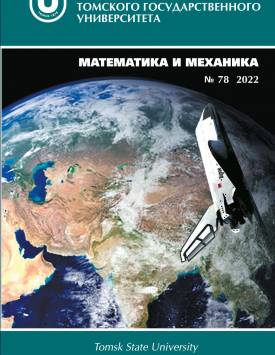To the issue of the modeling of oxide film fracture during aluminum particle ignition
Aluminum particles are coated with a protective oxide film. It is known that the oxide film condition controls the aluminum oxidation kinetics. The fracture of the film induces the intensification of oxidation. This feature encourages authors to simulate the film condition after fraction caused by thermomechanical stress. The static strength of the film is a well-studied issue, while the fracture dynamics is still a relevant problem. In this paper, two coefficients describing the film condition after fraction are proposed. The first is based on the ratio of activation rates of critical flaws at the fracture initiation and in a hypothetical case without oxide film relaxation. The second represents the ratio of total times of the activated flaw growth during fracture and under specific reference conditions. Both coefficients are shown to produce adequate results with regard to predicting of more sufficient fractures at higher stress rates. It is assumed that the aluminum particle surface, which is exposed to an oxidizer after film fracture, is proportional to the proposed coefficients. With this assumption, the particle ignition is simulated. It is shown that higher rates of particle heating during ignition induce considerable fractures of the oxide film and the following intense oxidation.
Keywords
ignition,
aluminum,
alumina,
fracture,
kinetics,
oxidationAuthors
| Babuk Valeriy A. | Baltic State Technical University «VOENMEH» | babuk_va@mail.ru |
| Budnyi Nikita L. | Baltic State Technical University «VOENMEH» | budnyi_nl@voenmeh.ru |
Всего: 2
References
Babuk V.A., Budnyi N.L., Nizyaev A.A. Simulation of Condensed Products Formation at the Surface of a Metalized Solid Propellant // Innovative Energetic Materials: Properties, Combustion Performance and Application / W. Pang, L. DeLuca, A. Gromov, A. Cumming (eds). Singapore : Springer, 2020. P. 523-547. doi: 10. 1007/978-981-15-4831 -4_17
Rosenband V., Gany A., Timnat Y.M. Effect of mechanical stresses on heterogeneous oxidation of metals // Oxidation of Metals. 1995. V. 43, No. 1. P. 141-156. doi: 10.1007/BF01046751
Crump J.E., Prentice J.L., Kraeutle K.J. Role of scanning electron microscope in the study of propellant combustion. I. Behavior of metal additives // Combustion Science and Technology. 1969. V. 1, No. 3. P. 205-223. doi: 10.1080/00102206908952201
Локенбах А.К., Запорина Н.А., Книпеле А.З., Строд В.В., Лепинь Л.К. Влияние условий нагрева на агломерацию порошкообразного алюминия в атмосфере воздуха // Физика горения и взрыва. 1985. Т. 21, № 1. С. 73-82. doi: 10.1007/BF01471142
Похил П.М., Беляев А.Ф., Фролов Ю.В. и др. Горение порошкообразных металлов в ак тивных средах. М. : Наука, 1972. 294 с.
Sundaram D.S., Puri P., Yang V. A general theory of ignition and combustion of nano- and micron-sized aluminum particles // Combustion and Flame. 2016. V. 169. P. 94-109. doi: 10.1016/j.combustflame.2016.04.005
Федоров А.В., Харламова Ю.В. Воспламенение частицы алюминия // Физика горения и взрыва. 2003. Т. 39, № 5. С. 65-68. doi: 10.1023/A: 1026109801863
Babuk V.A., Budnyi N.L. Smoke oxide particles formation at the burning surface of condensed systems // Acta Astronautica. 2019. V. 158. P. 264-271. doi: 10.1016/j.actaastro.2019.03.031
Denoual C., Barbier G., Hild F. A Probabilistic Approach for Fragmentation of Brittle Materials under Dynamic Loading // Comptes rendus de l’Academie des sciences. Serie IIb, Meca-nique. 1997.V. 325 (12). p. 685-691. doi: 10.1016/S1251-8069(97)82333-0
Hild F., Denoual C., Forquin P., Brajer X. On the probabilistic-deterministic transition involved in a fragmentation process of brittle materials // Computers and Structures. 2003. V. 81, № 12. P. 1241-1253. doi: 10.1016/S0045-7949(03)00039-7
Forquin P., Hild F. A Probabilistic Damage Model of the Dynamic Fragmentation Process in Brittle Materials // Advances in Applied Mechanics. 2010. V. 44. P. 1-72. doi: 10.1016/S0065-2156(10)44001 -6
Forquin P. Brittle materials at high-loading rates: an open area of research // Philosophical Transactions of the Royal Society A: Mathematical, Physical and Engineering Sciences. 2017. V. 375, No. 2085. Art. 20160436. doi: 10.1098/rsta.2016.0436
Rosenband V., Gany A. A Microscopic and Analytic Study of Aluminum Particles Agglomeration // Combustion Science and Technology. 2001. V. 166, No. 1. P. 91-108. doi: 10.1080/00102200108907821
Danzer R., Supancic P., Pascual J., Lube T. Fracture statistics of ceramics - Weibull statistics and deviations from Weibull statistics // Engineering Fracture Mechanics. 2007. V. 74, No. 18. P. 2919-2932. doi: 10.1016/j.engfracmech.2006.05.028
Rosier J., Harders H., Baker M. Mechanical Behaviour of Engineering Materials. Metals, Ceramics, Polymers, and Composites. Berlin: Springer-Verlag, 2007. XV, 534 р. doi: 10.1016/C2013-0-01916-0

